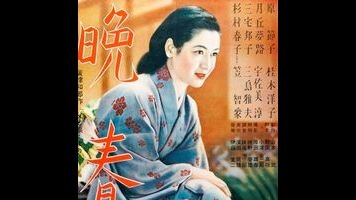Ozu’s late-period work is often described as “tranquil” or “contemplative,” though it’s actually very visually bold, with an intensified sense of geometry, figure, and line, and a wild disregard for the rules of continuity editing, which makes every shot discrete from the others. Like many great filmmakers, he developed through imitation (the lurid, baroque Josef Von Sternberg was an important influence) and elimination, the end result being a personal toolkit of essentials and pet obsessions. The Ozu-verse is notoriously limited, turning critics into bingo callers. In Late Spring, one finds: Ryû, Ozu’s good luck charm, who appeared in almost three dozen movies for the director; a particular Tokyo building (previously seen in the director’s darkest film, A Hen In The Wind) with a Time-Life logo painted on the side, made poignant by the subject matter; a reference to Hollywood romance in the form of a comparison of a man’s good looks to Gary Cooper; cicadas and trains, both of which run in cycles; and so on and so forth.
And there is also Hara, who would become the beaming muse of Ozu’s mature style. The performances in Ozu’s later films, including Late Spring, tend to be artificial; everyone sits leaning forward, their backs stiff as they laugh, and speaks in a cadence that suggests a world of people trying to reassure one another. Is it a fantasy space? Ozu made films about parenthood, old age, the white-collar middle-class, and marriage, despite having never experienced any of those things first hand; he never married or had kids, worked almost his entire adult life for the Shochiku film studio, and died on his 60th birthday. There’s a lot to suggest that he was gay, and it’s true that his portraits of single women who feel pressured into marriage—including Late Spring’s Noriko—often suggest queer themes, relayed in gender-swapped code. (Additionally, the close relationship between Noriko and Shukichi echoes the one Ozu had with his mother, with whom he lived.)
Then again, the films of his mature period contain so many shades of insight about people and how they relate to each other that it’s possible to interpret them in many ways; it’s all there. Generations of directors have tried to imitate his late-period style, rarely successfully; like so many seemingly simple things, it’s the product of unique genius. Here, a viewer finds Ozu’s vivid graphic sense in peak form: the way he frames Noriko’s divorcée friend Aya (Yumeji Tsukioka) when she’s talking to Shukichi, the almost triangular silhouette created by the padded shoulders of her blouse contrasting with the slouched lines of the old man’s robe; the careful placement of bicycle wheels and of a diamond-shaped Coca-Cola sign during a visit to the beach; the lines of motion of the scene where father and daughter walk apart down a street, which is one of the only sequences in the film to feature extensive camera movement.
Each shot in Late Spring is striking on its own; the mature Ozu belongs to that rare category of filmmakers whose work can be recognized from a single frame. But together—with all their abrupt shifts in visual perspective and time—they become a mosaic, deeply poignant and ultimately mysterious in the way it envisions a relationship between two people trapped by how much they care for one another. There are domestic dramas, and then there’s this.









































